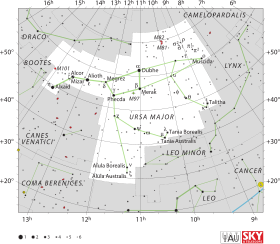HD 84406
HD 84406
| Ascension droite | 09h 47m 30,5453s[1] |
|---|---|
| Déclinaison | +63° 14′ 52,088″[1] |
| Constellation | Grande Ourse |
| Magnitude apparente | 6,944[2] |
Localisation dans la constellation : Grande Ourse | |
| Type spectral | G8IV[3] |
|---|
| Vitesse radiale | 6,97 km/s |
|---|---|
| Mouvement propre |
μα = −108,160 ± 0,023 mas/a[1] μδ = −137,000 ± 0,029 mas/a[1] |
| Parallaxe | 12,557 ± 0,028 2 mas[1] |
| Distance | 79,637 ± 0,179 pc (∼260 al)[1] |
| Masse | 1,4 M☉[4] |
|---|---|
| Rayon | 5,1 R☉[5] |
| Gravité de surface (log g) | 3,355[6] |
| Luminosité | 13,7 L☉[5] |
| Température | 4,905 K[5] |
| Métallicité | −0,055[6] |
| Âge | 4,5 × 109 a[7] |
Désignations
HD 84406 est une étoile se situant approximativement à ∼ 260 a.l. (∼ 79,7 pc)[1] dans la constellation de la Grande Ourse. Il s'agit d'une étoile de type spectral G et avec un mouvement propre élevé[8].
Le 4 février 2022, HD 84406 fut la première étoile observée par le télescope spatial James Webb. L'étoile étant isolée dans le ciel, elle est utilisée pour tester et aligner la focale des 18 miroirs primaires du télescope[9],[10],[11],[12]. Le 11 février 2022, The New York Times annonça que les "premiers photons" des images de HD 84406 du JWST avaient été publiés - ainsi que la vidéo[13] associée de la NASA.
Galerie[modifier | modifier le code]
-
Selfie: Miroir primaire du télescope spatial James Webb à destination.
-
Images de la même étoile HD 84406 vue par chacun des 18 segments du miroir primaire avant alignement.
-
Image annotée du nom des 18 segments du miroir observant chacun la même étoile HD 84406.
Références[modifier | modifier le code]
- (en) A. G. A. Brown et al. (Gaia collaboration), « Gaia Early Data Release 3 : Summary of the contents and survey properties », Astronomy & Astrophysics, vol. 649, , article no A1 (DOI 10.1051/0004-6361/202039657, Bibcode 2021A&A...649A...1G, arXiv 2012.01533). Notice Gaia EDR3 pour cette source sur VizieR.
- « HYGMap »
- Helmut A. Abt, « Spectral Classification of Stars in A Supplement to the Bright Star Catalogue », The Astrophysical Journal Supplement Series, vol. 155, no 1, , p. 175–177 (DOI 10.1086/423803
 , Bibcode 2004ApJS..155..175A)VizieR
, Bibcode 2004ApJS..155..175A)VizieR
- A. B. A. Queiroz, F. Anders, C. Chiappini, A. Khalatyan, B. X. Santiago, M. Steinmetz, M. Valentini, A. Miglio, D. Bossini, B. Barbuy, I. Minchev, D. Minniti, D. A. García Hernández, M. Schultheis, R. L. Beaton, T. C. Beers, D. Bizyaev, J. R. Brownstein, K. Cunha, J. G. Fernández-Trincado, P. M. Frinchaboy, R. R. Lane, S. R. Majewski, D. Nataf, C. Nitschelm, K. Pan, A. Roman-Lopes, J. S. Sobeck, G. Stringfellow et O. Zamora, « From the bulge to the outer disc: Star Horse stellar parameters, distances, and extinctions for stars in APOGEE DR16 and other spectroscopic surveys », Astronomy & Astrophysics, vol. 638, , A76 (DOI 10.1051/0004-6361/201937364, Bibcode 2020A&A...638A..76Q, arXiv 1912.09778, S2CID 209439697)
- I. McDonald, A. A. Zijlstra et R. A. Watson, « Fundamental parameters and infrared excesses of Tycho–Gaia stars », Monthly Notices of the Royal Astronomical Society, vol. 471, no 1, , p. 770–791 (ISSN 0035-8711, DOI 10.1093/mnras/stx1433
 , Bibcode 2017MNRAS.471..770M, arXiv 1706.02208)
, Bibcode 2017MNRAS.471..770M, arXiv 1706.02208)
- Daniel J. Stevens, Keivan G. Stassun et B. Scott Gaudi, « Empirical Bolometric Fluxes and Angular Diameters of 1.6 Million Tycho-2 Stars and Radii of 350,000 Stars with Gaia DR1 Parallaxes », The Astronomical Journal, vol. 154, no 6, , p. 259 (ISSN 0004-6256, DOI 10.3847/1538-3881/aa957b
 , Bibcode 2017AJ....154..259S, arXiv 1708.05025)
, Bibcode 2017AJ....154..259S, arXiv 1708.05025)
- Diane K. Feuillet, Jo Bovy, Jon Holtzman, Léo Girardi, Nick MacDonald, Steven R. Majewski et David L. Nidever, « Determining Ages of APOGEE Giants with Known Distances », The Astrophysical Journal, vol. 817, no 1, , p. 40 (DOI 10.3847/0004-637X/817/1/40, Bibcode 2016ApJ...817...40F, arXiv 1511.04088, S2CID 118675933)
- (en) HD 84406-- High proper-motion Star sur la base de données Simbad du Centre de données astronomiques de Strasbourg.
- George Dvorsky, « Webb Space Telescope Successfully Sees Its First Glimmer of Light - HD 84406 will go down in history as the first star spotted by the $10 billion space telescope. », Gizmodo, (lire en ligne, consulté le )
- Alan Boyle, « Webb Telescope fires thrusters to settle in at destination, a million miles from Earth », sur GeekWire, (consulté le )
- Alise Fisher, « The Webb Team Looks Back on Successful Deployments », sur James Webb Space Telescope (NASA Blogs), (consulté le )
- Abby Lee Hood, « The James Webb Space Telescope Just Detected Its First Signal - We're Watching The Future Unfold In Real Time, », Futurism.com, (lire en ligne, consulté le )
- « Photons Received: Webb Sees Its First Star – 18 Times » (consulté le )




